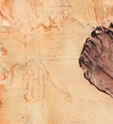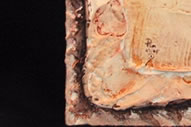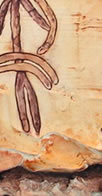BOOMERANG FIGURE
COLORS are derived from natural pigments of fresh blueberry wash, ground clay and yellow ochre. Dirt from Maroon Bell, Colorado is incorporated into the color to give it its red/maroon cast. Maroon Bell is located near Maroon Lake , which is at an altitude of 9,580 ft. The lake is in a basin that was sculpted by Ice Age glaciers. It took nature 300 million years to form the landscaping in this glacial valley with peaks that reach 14,000 feet, making up part of the Rocky Mountains . The red color from the dirt in this area is the result of weathering of hematite, an iron-bearing mineral.
BACKGROUND is a pure white base.
TEXTURING is achieved by applying five layers of gypsum using a layering technique. This heavy texturing accents the “head” of the figure. Edges are heavily carved, adding to the layering effect.
SIZE is 15 ½” H x 15” W
CULTURAL INSPIRATION: The boomerang has become the cultural symbol of the Australian Aboriginals and an all- purpose utensil often used to clear grasses for camp sites, a shovel during cooking and food preparation and a defensive weapon and ritual instrument. For rituals, they are carefully selected for each ceremony from a curved limb of a mulga tree. They may be coated in red ochre and elaborately decorated. Boomerangs were initially developed from clubs and throwing sticks to be hurled at enemy or prey. They are made in many sizes and shapes; the best known is the returning type. The returning boomerang is thin and very light with a deep curve; its ends being slightly twisted in opposite directions to help improve flight. Returning boomerangs were invented to use during bird hunting and were instrumental in directing animals into traps. From Central Australia comes a very distinctive hooked boomerang that is used for fighting. The hook was used on one end to grasp onto a shield during a fight and then swing the weapon around to strike the defender. This simple male figure in this piece of art is holding a boomerang in each hand and two more are tucked into his hair belt, a common form of male apparel. It comes from rock art at Maddjurnai. Suspended from the belts are bustles and pubic aprons. In some locations, pubic coverings consisted of lengths of string attached to a string waistband. Fiber string is an important element in aboriginal fiber craft. String made from vegetable fiber is created by a rolling motion of two strands of fiber on the thigh. This skilled motion allows the fibers to twist together and the ply is consolidated on the backward movement creating a string of any length by adding in new pieces of fiber as needed. |














